INDIA AT INDEPENDENCE (1947)
India’s struggle for independence was marked by decades of resistance against British colonial rule. The Revolt of 1857 is considered the first significant uprising against British rule, followed by a series of movements led by the Indian National Congress (INC), including the Non-Cooperation Movement (1920–22), Civil Disobedience Movement (1930–34), and Quit India Movement (1942). Leaders like Mahatma Gandhi, Jawaharlal Nehru, Sardar Patel and Subhas Chandra Bose played a crucial role in uniting the nation and guiding it toward independence. 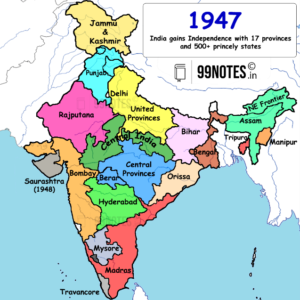 The independence movement was not just political but also aimed at achieving social justice and economic self-reliance.
The independence movement was not just political but also aimed at achieving social justice and economic self-reliance.
Impact of colonial rule
Colonial rule in India profoundly transformed its economy, society, and politics. The British exploited India’s resources, reshaped social structures, and imposed political control, leaving a lasting impact on the nation’s development.
- Economic Impact: Deindustrialization due to the destruction of indigenous industries, introduction of the Zamindari system leading to agrarian distress, and the drain of wealth through unequal trade policies and high taxation.
- Social Impact: Promotion of social divisions through the “divide and rule” policy, Western education introduced modern ideas but also created a cultural rift, and emergence of social reform movements (Brahmo Samaj, Arya Samaj) to address caste discrimination and promote gender equality.
- Political Impact: Establishment of a centralized administration and legal system, formation of the Indian National Congress in 1885 as a political platform, and growing demand for self-governance under the framework of constitutional reforms (Government of India Acts 1909, 1919, 1935).
The partition of India on August 15, 1947, created two nations, India and Pakistan, based on religious lines. It led to mass communal violence with over 1 million deaths and the displacement of 15 million people, making it one of the largest forced migrations in history. Both countries faced a refugee crisis and political instability due to the division of resources. The Kashmir conflict emerged as a major issue, resulting in the First Indo-Pak War (1947–48).
After gaining independence on August 15, 1947, India faced the monumental task of building a democratic and sovereign nation from the ruins of colonial rule and the trauma of partition. The newly independent state had to address challenges such as:
- Political integration of over 560 princely states.
- Establishing a parliamentary democracy with a secular and federal structure.
- Framing a comprehensive Constitution that would define the rights and duties of the citizens and the framework of governance.
- Managing the first general elections in 1952, which laid the foundation for a Multy- party political system.
- Strengthening institutions like the Election Commission, Judiciary and Bureaucracy to ensure political stability and rule of law.
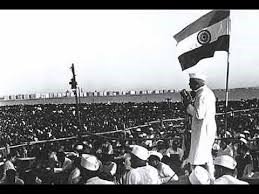 Political Transition and Challenges
Political Transition and Challenges
After gaining independence in 1947, India faced the enormous task of transitioning from a colonial regime to a functioning democratic republic. The process involved adopting a democratic system, drafting a comprehensive constitution, establishing a stable political framework and ensuring the political integration of princely states.
1. Adoption of a democratic system
India adopted a parliamentary system of democracy modelled on the British system, but with universal adult suffrage, allowing every citizen aged 21 and above (later lowered to 18) the right to vote. This was a revolutionary step for a newly independent nation with widespread poverty, illiteracy, and social inequality. The democratic framework included:
- A bicameral legislature at the centre (Lok Sabha and Rajya Sabha).
- A multi-party system that allowed diverse political representation.
- A strong central government with a federal structure where powers were distributed between the centre and the states through the Union List, State List, and Concurrent List.
- The establishment of key democratic institutions such as the Election Commission, ensuring free and fair elections.
- Regular general elections starting with the first general election in 1952 under the leadership of Sukumar Sen, the first Chief Election Commissioner.
The Constituent Assembly was formed in 1946 with 389 members, including representatives from provinces, princely states, and nominated members. The drafting committee, chaired by Dr. B.R. Ambedkar, was tasked with framing the Constitution. The Constitution was influenced by the Government of India Act (1935), British parliamentary traditions, and elements from the constitutions of the USA, Ireland, and the Soviet Union.
2. Key milestones in the drafting process
The drafting of the Indian Constitution was a historic and meticulous process that shaped the foundation of independent India. It involved several crucial stages, from the formation of the Constituent Assembly to the final adoption of the Constitution.
- Objectives Resolution proposed by Jawaharlal Nehru in December 1946 laid the foundation for a sovereign, socialist, secular, and democratic republic.
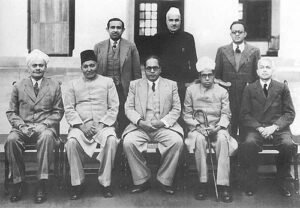 Inclusion of Fundamental Rights (inspired by the US Bill of Rights) and Directive Principles of State Policy (inspired by the Irish Constitution) ensured social and economic justice.
Inclusion of Fundamental Rights (inspired by the US Bill of Rights) and Directive Principles of State Policy (inspired by the Irish Constitution) ensured social and economic justice.- Adoption of a parliamentary system with a federal structure but a strong centre to maintain national unity and stability.
- Provision for an independent judiciary to uphold constitutional values and protect citizens’ rights.
- The Constitution was adopted on November 26, 1949 and came into effect on January 26, 1950.
Jawaharlal Nehru, as India’s first Prime Minister, played a defining role in shaping the political, economic, and social landscape of independent India. His leadership focused on building a modern, industrial, and technologically advanced nation.
3. Key policies and initiatives
At the time of independence, India introduced several foundational policies and initiatives to establish political stability, promote economic growth, and address social challenges. These early measures laid the groundwork for nation-building and democratic governance.
- Industrial Policy Resolution (1948): Laid the foundation for a mixed economy, where the state would control key industries while allowing private enterprise.
- Five-Year Plans: Launched the First Five-Year Plan (1951–56) with a focus on agricultural production, infrastructure, and community development.
- Non-Alignment Movement (NAM): Nehru’s foreign policy aimed at maintaining strategic independence by avoiding alignment with any major power bloc (USA or USSR) during the Cold War.
- Education and scientific advancement: Established institutions like IITs, IIMs, and CSIR to promote higher education and scientific research.
- Social reforms: Focused on removing caste-based discrimination, empowering women, and promoting secularism.
- Land reforms: Abolished the zamindari system and introduced land ceiling laws to address rural inequality and promote agricultural productivity.
4. Challenges of integrating princely states
One of the most difficult challenges post-independence was the integration of over 560 princely states into the Indian Union. These princely states, which had enjoyed semi-autonomous status under British rule, were given the choice to join India or Pakistan or remain independent. Sardar Vallabhbhai Patel, as the Home Minister, led the integration process using a combination of persuasion, negotiation, and strategic action.
- Instrument of Accession: Princely states were invited to sign the Instrument of Accession, which allowed them to retain internal autonomy while surrendering control over defence, foreign affairs, and communications to the Indian government.
Patel’s decisive actions and diplomatic skills ensured that India emerged as a united political entity, setting the foundation for a strong and stable central government.
(We will deal with integration of princely states in details in next chapter.)
| Maulana Abul Kalam Azad’s Contribution (PYQ 2013) |
|
Maulana Abul Kalam Azad was a prominent Indian scholar, freedom fighter, and political leader whose contributions to India’s freedom struggle and post-independence development were significant. His vision and leadership in various spheres shaped modern India’s political, educational, and cultural landscape. Pre-Independence Contributions
Post-Independence Contributions
Maulana Azad’s contributions shaped India’s path to independence and its post-independence development, making him a key figure in promoting unity, secularism, and educational empowerment in the nation. |
Partition and Its Aftermath
The partition of British India in 1947 led to the creation of India and Pakistan, resulting in one of the largest and most tragic mass migrations in history. It caused widespread communal violence, loss of lives, and displacement of millions. The newly independent Indian government faced the immediate challenge of resettling refugees and maintaining social harmony.
1. Causes of Partition
The partition of British India in 1947 was driven by deep-rooted religious, political, and social divides between Hindus and Muslims. The demand for a separate Muslim state, led by the Muslim League under Muhammad Ali Jinnah, ultimately resulted in the creation of Pakistan.
- Hindu-Muslim tensions: British colonial rule exacerbated religious differences through the policy of “divide and rule.” The demand for a separate Muslim state intensified after the passage of the Government of India Act, 1935 and the rise of the Muslim League under Muhammad Ali Jinnah.
- Two-Nation Theory: The Muslim League propagated the idea that Hindus and Muslims were two distinct nations with irreconcilable religious and cultural differences.
- Failure of Cabinet Mission Plan (1946): The plan proposed a united India with autonomy for Muslim-majority provinces, but disagreements between the Congress and the Muslim League led to its collapse.
- Direct Action Day (August 16, 1946): Jinnah called for direct action to press the demand for Pakistan, leading to communal riots in Calcutta, resulting in over 5,000 deaths and escalating Hindu-Muslim tensions.
- Mountbatten Plan (1947): British Viceroy Lord Louis Mountbatten proposed the division of India based on religious lines, leading to the creation of India and Pakistan on August 15, 1947.
2. Consequences of Partition
 The Partition of British India in 1947 had profound and far-reaching consequences, leading to mass displacement, communal violence, and strained Indo-Pak relations that persist to this day. It reshaped the political, social, and economic landscape of the subcontinent.
The Partition of British India in 1947 had profound and far-reaching consequences, leading to mass displacement, communal violence, and strained Indo-Pak relations that persist to this day. It reshaped the political, social, and economic landscape of the subcontinent.
- Mass Migration and Displacement – Around 15 million people were displaced as Hindus and Sikhs moved to India and Muslims to Pakistan, making it one of the largest forced migrations in history.
- Communal Violence – Widespread riots, massacres, and abductions resulted in the death of nearly 1 to 2 million people, deepening communal divides.
- Loss of Property and Economic Disruption – Migrants left behind land and wealth, causing economic instability and financial strain on both nations.
- Political Instability and Wars – Partition created deep-rooted political tensions, leading to multiple wars between India and Pakistan over territorial disputes like Kashmir.
- Impact on Minorities – Religious minorities faced persecution and insecurity in both India and Pakistan, forcing many to migrate or live under threat.
- Psychological and Cultural Impact – The trauma of Partition left a lasting emotional and cultural scar, influencing literature, films, and collective memory in both countries.
3. Refugee crisis
The Partition of 1947 triggered a massive refugee crisis, with around 15 million people displaced across newly created India and Pakistan. The Indian government undertook large-scale rehabilitation efforts to provide shelter, jobs, and social integration to the displaced population.
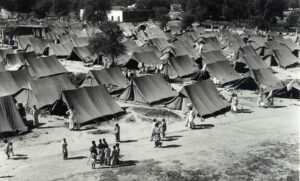 Camps and rehabilitation centres were established to provide shelter and food to displaced families.
Camps and rehabilitation centres were established to provide shelter and food to displaced families.- The government introduced the Rehabilitation Finance Administration (RFA) in 1948 to provide financial assistance for rebuilding lives.
- Land redistribution and employment programs were introduced to help refugees integrate into society.
- Punjab and Delhi absorbed the highest number of refugees, leading to the rapid expansion of urban centres.
- Displaced Persons Act (1954) provided legal support and compensation to refugees.
4. India-Pakistan relations
The Partition left unresolved territorial disputes, particularly over Jammu and Kashmir, which became a major point of conflict between India and Pakistan. The first war over Kashmir broke out in 1947-48, leading to the establishment of the Line of Control (LoC). This territorial tension has shaped the trajectory of India-Pakistan relations for decades.
- Accession of Kashmir: Maharaja Hari Singh of Jammu and Kashmir initially sought to remain independent. However, after Pakistani-backed tribal forces invaded in October 1947, he signed the Instrument of Accession with India.
- First Indo-Pak War (1947–48): India sent military forces to push back the invaders. The war ended with a ceasefire brokered by the United Nations in January 1949, establishing the Line of Control (LoC).
- Long-term impact: Kashmir remained a contentious issue, leading to multiple wars and ongoing political and military tensions between India and Pakistan.
Economic Situation at Independence
At the time of independence in 1947, India inherited a fragile and underdeveloped economy weakened by nearly 200 years of British colonial rule. The country faced massive challenges in rebuilding its economic foundations, improving industrial capacity, addressing food shortages, and defining the path of future economic development.
1. Colonial economic drain
British colonial policies had drained India’s wealth, leaving the country economically weak and industrially underdeveloped at the time of independence. The new leadership faced the challenge of rebuilding the economy and promoting industrial growth.
- Deindustrialization: The British imposed heavy tariffs on Indian goods while encouraging the import of British manufactured products, leading to the collapse of traditional Indian industries (e.g., textiles).
- Agrarian exploitation: The British introduced systems like Zamindari and Ryotwari, which led to high land revenue demands and forced farmers into debt and poverty.
- Drain of wealth: According to Dadabhai Naoroji’s “Drain Theory,” British policies siphoned off India’s wealth to Britain, leaving the country with limited capital for industrial and infrastructural growth.
- Neglect of infrastructure: While railways were built for colonial administrative convenience, industrial infrastructure like power plants and factories were neglected.
- Import dependency: India became dependent on the export of raw materials and the import of finished goods, leading to trade imbalances.
2. Agrarian challenges and food scarcity
Agriculture was the backbone of India’s economy at independence, but it faced severe challenges like low productivity, fragmented landholdings, and outdated farming techniques. Ensuring food security and improving rural livelihoods became a top priority for the new government.
- Low productivity: Traditional farming methods and lack of irrigation facilities resulted in poor yields.
- Fragmentation of landholdings: The Zamindari system and inheritance practices led to fragmented and economically unviable farms.
- Food shortage: The Bengal Famine of 1943, which killed over 2 million people, exposed the vulnerability of India’s food supply system.
- Land reforms: The government attempted to introduce land redistribution and abolition of the Zamindari system to address rural inequality.
- Community Development Programme (1952): This aimed to introduce modern agricultural practices and improve rural infrastructure.
3. Need for economic planning
Recognizing the need for a structured approach to economic recovery, India adopted a socialist-inspired model of economic planning, emphasizing state control over key industries and resource allocation. This approach aimed to promote self-reliance, reduce inequalities, and accelerate development.
- Planning Commission (1950): Established under Jawaharlal Nehru to formulate and oversee national economic plans.
- First Five-Year Plan (1951–56): Focused on agriculture, irrigation, and infrastructure development, targeting increased food production and land reform, with major projects like the Bhakra Nangal Dam.
- Second Five-Year Plan (1956–61): Focused on industrialization and heavy industries, following the Mahalanobis Model to promote capital goods industries and build a strong industrial base.
Post-Independence Social and Cultural Initiatives
Post-independence India faced significant social and cultural challenges in building a cohesive national identity while addressing deep-rooted social inequalities and regional diversities. The government undertook major reforms to promote social justice, linguistic harmony, and gender equality, while strengthening the education system to lay the foundation for a modern and progressive India.
1. Linguistic and regional diversity
India’s vast linguistic and regional diversity created challenges for national integration after independence. The demand for linguistic states led to the formation of the States Reorganization Commission (1953) and the creation of states based on language in 1956. This helped address regional aspirations while maintaining national unity.
- Linguistic diversity: India had over 1,600 languages and dialects, creating the need for a balanced language policy.
- Official language debate: The Constituent Assembly declared Hindi in the Devanagari script as the official language, but resistance from southern states led to the adoption of English as an associate official language.
- State Reorganization Act (1956): Based on the recommendations of the States Reorganisation Commission (headed by Fazal Ali), India reorganized states along linguistic lines. States like Andhra Pradesh (first linguistic state), Maharashtra, Gujarat, and others were formed. This helped reduce regional tensions but also encouraged regional political identities.
- Regional tensions: The linguistic and regional aspirations often led to political unrest and demands for separate states (e.g., Punjab, Nagaland).
2. Abolition of untouchability
Caste-based discrimination was a deeply entrenched social issue that needed strong constitutional and legal reforms. The Indian Constitution, led by Dr. B.R. Ambedkar, outlawed untouchability and introduced affirmative action through reservations in education, jobs, and political representation to uplift marginalized communities.
- Role of Dr. B.R. Ambedkar: As the Chairman of the Drafting Committee, Ambedkar ensured strong constitutional protection for marginalized communities. Article 17 of the Indian Constitution abolished untouchability and criminalized its practice.
- Reservation policy: The Constitution introduced reservations for Scheduled Castes (SC), Scheduled Tribes (ST), and later Other Backward Classes (OBC) in education, government jobs, and political representation.
- Protection of Civil Rights Act (1955): Made the practice of untouchability a punishable offense.
- Social reform movements: Dalit leaders like Jagjivan Ram and organizations like the Dalit Panthers fought for equal rights and political empowerment.
- Constitutional safeguards: The establishment of the National Commission for Scheduled Castes and National Commission for Scheduled Tribes ensured continued protection of Dalit and tribal rights.
3. Women’s rights and gender equality
The Indian government introduced legal and policy measures to promote women’s empowerment and gender equality. Key initiatives included granting women equal voting rights, enacting the Hindu Code Bill to secure property and marriage rights, and increasing women’s representation in politics and education.
- Constitutional Provisions: Article 14 ensured equality before the law, Article 15(3) allowed special provisions for women and children, and Article 39(d) mandated equal pay for equal work.
 Legal Reforms: The Hindu Code Bill (1955–56) granted Hindu women rights in marriage, divorce, inheritance, and property; the Prohibition of Child Marriage Act (1978) raised the legal marriage age; and the Dowry Prohibition Act (1961) criminalized dowry.
Legal Reforms: The Hindu Code Bill (1955–56) granted Hindu women rights in marriage, divorce, inheritance, and property; the Prohibition of Child Marriage Act (1978) raised the legal marriage age; and the Dowry Prohibition Act (1961) criminalized dowry.- Political Participation: Vijaya Lakshmi Pandit became the first female cabinet minister in 1952, and Indira Gandhi later became the first woman Prime Minister, reflecting increased female participation in politics.
- Education and Employment: State-funded policies increased access to higher education and job opportunities, encouraging women’s greater involvement in public life.
4. Role of education in nation-building
Education was viewed as a crucial tool for promoting social justice, economic growth, and national unity. The government introduced policies to expand access to primary, secondary, and higher education, focusing on marginalized communities. Institutions like IITs and IIMs were established to create a skilled workforce and drive technological and managerial advancement.
- University Grants Commission (UGC) – 1953: Established to regulate higher education and promote the creation of institutions like IITs and IIMs. It aimed to improve the quality and accessibility of higher education.
- Three-Language Formula: Introduced to foster national integration by teaching Hindi, English, and a regional language. It aimed to balance linguistic diversity with national unity.
- First National Education Policy (1968): Focused on universal primary education and reducing the literacy gap. It emphasized scientific and technical education to support national development.
- Mid-Day Meal Scheme (1984): Introduced to improve school attendance and child nutrition. It aimed to reduce dropout rates and support child health.
Post-independence India witnessed significant progress in addressing social inequalities and promoting regional harmony. The constitutional and legal measures laid the foundation for a more just and inclusive society, although caste and gender-based discrimination remained persistent challenges.
Foreign Policy and Non-Alignment
After independence, India’s foreign policy was shaped by the vision of Jawaharlal Nehru, who sought to establish India as a sovereign, independent voice in global affairs. Nehru’s approach aimed to protect India’s strategic interests while promoting global peace, cooperation, and decolonization. The policy of non-alignment became the cornerstone of India’s foreign relations during the Cold War era.
1. Nehru’s vision for India’s foreign policy
Nehru shaped India’s foreign policy on the principles of non-alignment, peaceful coexistence, and anti-colonialism. He aimed to maintain strategic autonomy while fostering global peace and cooperation. Nehru laid down the foundational principles of India’s foreign policy based on:
- Panchsheel Agreement (1954): India and China signed the Panchsheel (Five Principles of Peaceful Coexistence) agreement.
- Peaceful coexistence: Nehru advocated for resolving international conflicts through dialogue and diplomacy.
 Decolonization: India supported the independence movements in Africa and Asia, opposing colonial domination.
Decolonization: India supported the independence movements in Africa and Asia, opposing colonial domination.- Opposition to military alliances: India refused to join military blocs like NATO and SEATO during the Cold War to maintain strategic autonomy.
2. India’s role in the Non-Aligned Movement
India played a leading role in the formation of the Non-Aligned Movement (NAM) in 1961 to maintain independence from the power politics of the Cold War between the USA and the USSR.
- Founding members: India (Nehru), Yugoslavia (Tito), Egypt (Nasser), Ghana (Nkrumah), and Indonesia (Sukarno).
- Principles of NAM:
- Maintaining sovereignty and territorial integrity.
- Opposition to colonialism, imperialism, and racism.
- Promoting economic cooperation among developing nations.
- Advocating for nuclear disarmament.
- Bandung Conference (1955): The foundation for NAM was laid at the Asian-African Conference held in Bandung, Indonesia, where Nehru stressed peaceful coexistence and anti-colonialism.
- Impact: NAM helped India establish itself as a leader of the developing world, promoting South-South cooperation and resisting the pressures of military alliances.
3. Relations with neighbouring countries
India’s early foreign policy was shaped by complex relations with neighboring countries like Pakistan, China, and Sri Lanka. The Kashmir conflict, the 1962 Sino-Indian War, and Tamil issues in Sri Lanka tested India’s diplomatic and military strength. Despite challenges, India pursued peaceful resolution and regional stability through strategic engagement.
1. Pakistan: Partition conflicts over assets and Kashmir created deep-rooted animosity between India and Pakistan. The First Indo-Pak War (1947–48) erupted due to Pakistan’s support for tribal invasions in Kashmir, leading to the establishment of the Line of Control (LoC). The Second Indo-Pak War (1965) followed Pakistani infiltration into Kashmir, ending with the Tashkent Agreement but without resolving the Kashmir issue. These conflicts established Kashmir as a central point of tension in bilateral relations.
2. China: India and China initially pursued peaceful relations through the Panchsheel Agreement (1954), focusing on mutual respect and non-aggression. However, tensions over border issues escalated into the Sino-Indian War (1962), where Chinese forces invaded Aksai Chin and Arunachal Pradesh. India faced a military defeat, exposing weaknesses in defence preparedness. Diplomatic relations remained strained, with recurring border conflicts continuing in later years.
3. Sri Lanka: India maintained friendly ties with Sri Lanka but became involved in the Tamil ethnic conflict in the 1980s. In 1987, India sent the Indian Peacekeeping Force (IPKF) to mediate the conflict, but the mission ended in failure. The involvement strained diplomatic relations and heightened tensions within Sri Lanka. India’s engagement in the Tamil issue remained a sensitive point in bilateral ties.
4. Early participation in international organizations
India actively engaged in shaping global institutions like the United Nations and the Commonwealth to strengthen its diplomatic presence. It supported peacekeeping missions and advocated for nuclear disarmament and a permanent seat in the UN Security Council. India’s balanced approach ensured strategic autonomy while promoting the interests of developing nations.
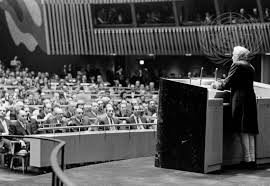 United Nations: India became a founding member of the United Nations (UN) in 1945, underscoring its commitment to global peace and cooperation. It actively supported UN peacekeeping missions in conflict zones like Korea, Congo, and Cyprus. India also championed global nuclear disarmament and advocated for a permanent seat in the UN Security Council. Its consistent diplomatic efforts highlighted India’s influential role in global governance.
United Nations: India became a founding member of the United Nations (UN) in 1945, underscoring its commitment to global peace and cooperation. It actively supported UN peacekeeping missions in conflict zones like Korea, Congo, and Cyprus. India also championed global nuclear disarmament and advocated for a permanent seat in the UN Security Council. Its consistent diplomatic efforts highlighted India’s influential role in global governance.
- Commonwealth of Nations: India chose to remain a member of the Commonwealth despite gaining independence from British colonial rule. This decision was aimed at maintaining diplomatic ties with Britain and other former colonies. India used the Commonwealth platform to strengthen political and economic ties.
- GATT and WTO: India became a member of the General Agreement on Tariffs and Trade (GATT) in 1948 to integrate into the global trade framework. Its participation reflected India’s balanced approach toward protecting domestic industries while engaging with global markets. In 1995, India became a founding member of the World Trade Organization (WTO), highlighting its commitment to a fair and rules-based international trade order. India continues to advocate for the interests of developing nations in trade negotiations.
Conclusion
India’s post-independence journey reflects resilience and progress, shaped by the legacy of the freedom movement. The Constitution institutionalized equality and justice, promoting social inclusion through affirmative action and women’s empowerment. Economic stability was driven by Five-Year Plans and a mixed economy model, while non-alignment ensured strategic autonomy. India’s democratic governance, peaceful power transitions, and balanced foreign policy set an example for other post-colonial nations.
Related FAQs of INDIA AT INDEPENDENCE (1947)
The Revolt of 1857 was the first major uprising, sparked by military grievances and broader discontent against British economic exploitation, social interference, and political control. It laid the foundation for future mass movements.
The INC evolved from a platform of moderate demands to launching mass civil disobedience movements like the Non-Cooperation Movement (1920–22), Civil Disobedience Movement (1930–34), and Quit India Movement (1942), uniting people across the country.
Leaders like Mahatma Gandhi (non-violent resistance), Jawaharlal Nehru (political vision), Sardar Patel (integration of princely states), and Subhas Chandra Bose (armed struggle) played vital roles in mobilizing the nation toward freedom.
Economically, India faced deindustrialization and wealth drain. Socially, divide-and-rule policies fueled communal divisions, while politically, India saw centralized administration but limited self-governance until the 20th century reforms.
India was partitioned into India and Pakistan, leading to massive violence and displacement. Post-independence, India focused on nation-building through democratic institutions, a new Constitution, economic planning, and social reforms.




